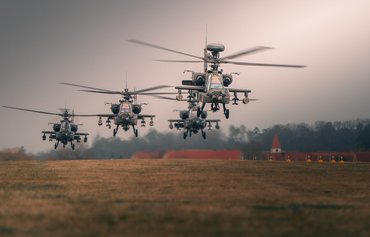During an April 8 evening helicopter raid in eastern Syria, forces from the US military's Central Command (CENTCOM) captured an "Islamic State of Iraq and Syria" (ISIS) attack facilitator and two of his associates.
"The capture of Hudayfah al-Yemeni and his associates will disrupt the organisation's ability to plot and carry out operations," said CENTCOM, which oversees US military operations in the Middle East.
The incident is the latest in a string of US helicopter raids in Syria that have targeted ISIS's top leaders, as well as operatives from other extremist groups.
US helicopters have retaliated quickly and with force to attacks from Iran-backed militias in Syria, and are capable of doing so again as necessary.
This was demonstrated last August when US attack helicopters struck several sites used by Iran-backed militants to fire rockets at bases housing US troops in northeastern Syria.
The helicopters destroyed "three vehicles and equipment used to launch some of the rockets" CENTCOM said, killing four Iran-backed militants allegedly responsible for one of the attacks.
US President Joe Biden said the US air and artillery strikes were ordered to protect US forces from attacks by Iran-backed militias, AFP reported.
"I directed the August 23 strikes in order to protect and defend the safety of our personnel . . . and to deter the Islamic Republic of Iran and Iran-backed militia groups from conducting or supporting further attacks on United States personnel and facilities," Biden said in a statement informing Congress of the action.
Biden said the strikes, which involved Apache attack helicopters, AC-130 gunships and M777 artillery, targeted a facility used by the attackers for logistics and ammunition storage.
"We made a concerted decision … to provide a proportional response here from a deterrence standpoint," said Pentagon spokesman Brig. Gen. Patrick Ryder.
Deterrent against fighter jets
With tensions running high between the United States and Iran, military analysts and experts have been considering how US military helicopters would fare against Iranian fighter jets during a potential conflict.
They note that US military helicopters are some of the most advanced in the world, equipped with the latest technology and weaponry and designed for a variety of missions, including reconnaissance, search and rescue, and air assault.
US military helicopters also feature advanced sensors and targeting systems, allowing them to detect and engage enemy fighters at long ranges, according to various military sources.
Their weapon systems have proven highly effective against enemy fighter jets, providing the helicopters with a significant advantage in aerial combat.
Iranian fighter jets -- such as the F-4 Phantom, F-5 Tiger and F-14 Tomcat -- are generally older aircraft that are less advanced than modern fighters used in many countries around the world.
Iran's aging and dilapidated civilian air fleet is likewise in need of a complete overhaul and upgrade, as the national carrier can neither acquire spare parts to repair non-operational airplanes nor procure new planes under sanctions.
The US Army's AH-64 Apache helicopters are seen particularly as a key deterrent to Iran.
More than 800 Apache helicopters are currently in service with the US Army, with 100 more expected to join the fleet in coming months.
Significant advantage over older jets
The Apache is a versatile helicopter that is capable of supporting a wide range of operations, from search and rescue missions to medical evacuation and recovery operations, according to the Operation Military Kids website.
The twin-engine helicopter is "fantastic at navigating difficult terrain and confined spaces", per the website.
Though the Apache is not designed to engage enemy fighter jets directly, it is capable of defending itself in a combat situation.
It is equipped with a 30mm M230 chain gun, which is capable of firing up to 625 rounds per minute and can engage enemy aircraft at short ranges.
It also is equipped with a range of air-to-air missiles, including the AIM-9 Sidewinder and the AIM-92 Stinger, which are designed to engage enemy aircraft at ranges of up to 8km.
The Apache's sensors and avionics systems give it a significant advantage over older fighter jets, as its radar system can detect enemy aircraft at long ranges.
Helicopter pilots using its electro-optical targeting system (EOTS) can view a high-resolution video image of the battlefield, which enables them to identify and engage enemy targets with precision.
Employed against fighter aircraft in close range, attack helicopters are deadly.
"A well-equipped attack helicopter flown by a trained crew will defeat most fighter airplanes in 1v1 [one-on-one] air combat, should the fighter be foolish enough to drop down to try and engage," said Nick Lappos, former US Army AH-1 Cobra attack helicopter pilot, on Quora, in 2020.

![US Army AH-64 Apaches sit on the flight line at Ali Al Salem Air Base in Kuwait on February 10. [US Air Force]](/cnmi_am/images/2023/04/17/41639-us-apache-helicopters-600_384.jpg)







Good
Reply2 Comment(s)
[Unintelligible] Muhammad and his family and companions!
Reply2 Comment(s)